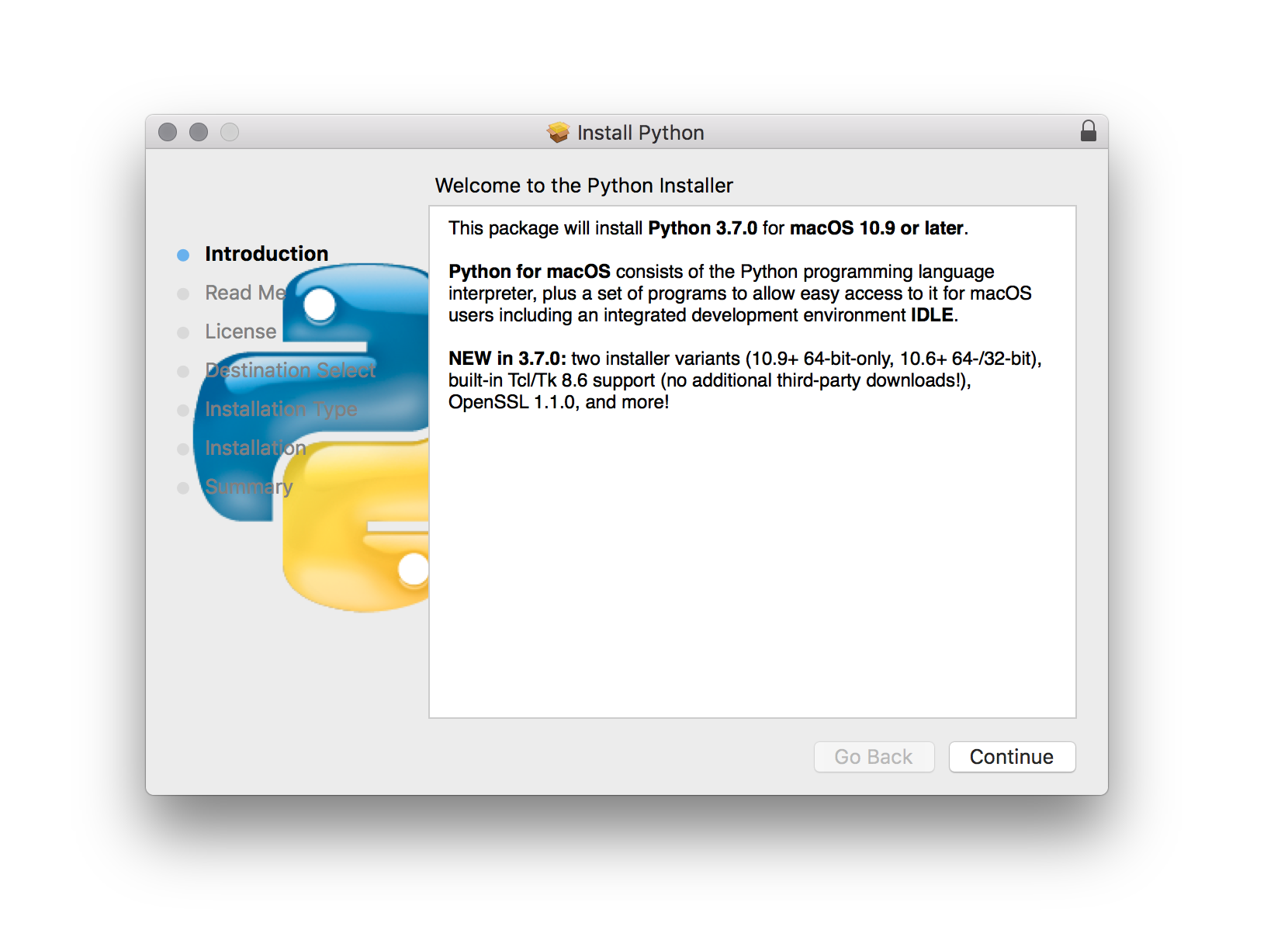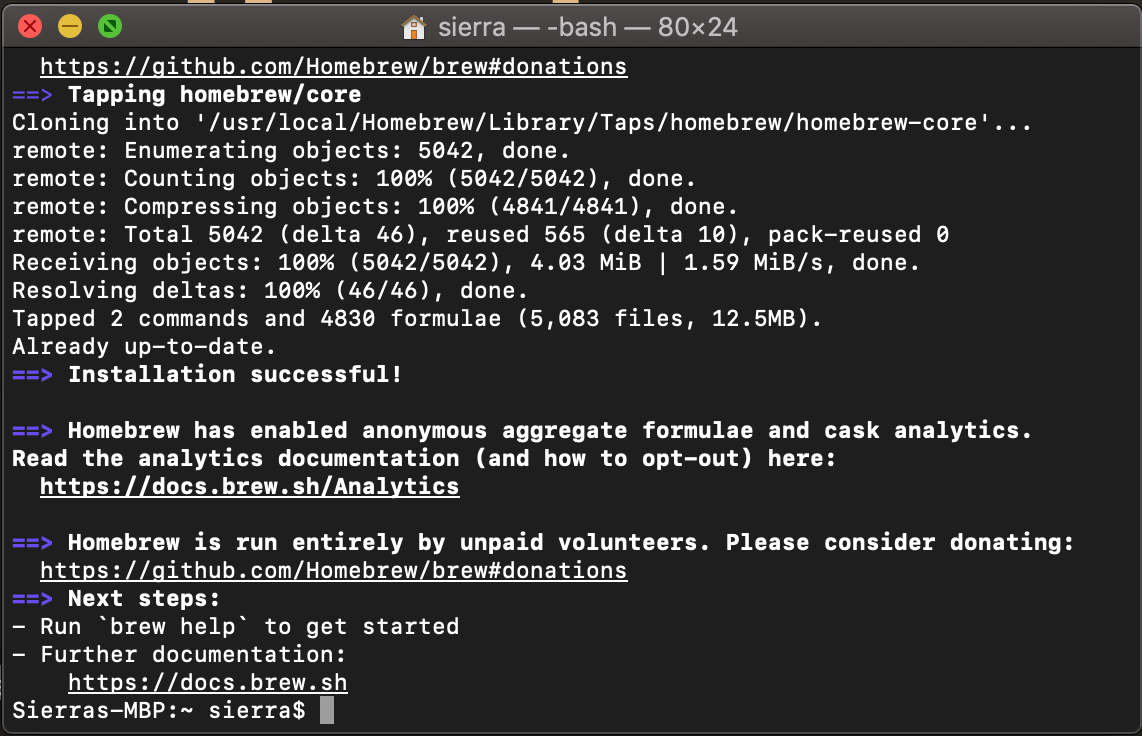
There are now newer security releases of Python 3.7 that supersede 3.7.9 and Python 3.9 is now the latest feature release of Python 3. Get the latest releases of 3.7.x and 3.9.x here. Python 3.7.8 was the last bugfix release of Python 3.7 before 3.7 entered the security-fix phase of its life cycle. The 'prefix scheme' is useful when you wish to use one Python installation to perform the build/install (i.e., to run the setup script), but install modules into the third-party module directory of a different Python installation (or something that looks like a different Python installation). May 07, 2020 Python 3.7 and newer will run on any Windows operating system except Windows XP. If you need to install Python 3 on XP, scroll down and click Download next to the most recently-updated version of Python 3.4. C: yourfolderx yourfolderypython.exe -m pip install bs4 with the syntax like the user post below: I just successfully installed a package for excel. After installing the python 3.6, you have to download the desired package, then install. For eg, python.exe -m pip download openpyxl2.1.4 python.exe -m pip install openpyxl2.1.4.
Python 3.7.9 was a security release of Python 3.7.
There are now newer security releases of Python 3.7 that supersede 3.7.9 and Python 3.9 is now the latest feature release of Python 3. Get the latest releases of 3.7.x and 3.9.x here.Python 3.7.8 was the last bugfix release of Python 3.7 before 3.7 entered the security-fix phase of its life cycle. We plan to provide security fixes until mid 2023, five years after its initial release. Note that there are updated binary installers available for 3.7.9.
Binary installers are normally not provided for security fix releases. However, since 3.7.8 was the last 3.7.x bugfix release and there are security fixes published in 3.7.9 that apply to users of some of the binary installers provided with 3.7.8, we have made an exception for 3.7.9 and are also updating the Windows and macOS binary installers. We do not plan to provide further binary updates for future 3.7.x security releases.
Please see the Full Changelog link for more information about the contents of this release and see What's New In Python 3.7 for more information about 3.7 features.

- PEP 537, 3.7 Release Schedule
- Report bugs at https://bugs.python.org.
- Help fund Python and its community.
There are now newer security releases of Python 3.7 that supersede 3.7.9 and Python 3.9 is now the latest feature release of Python 3. Get the latest releases of 3.7.x and 3.9.x here. Python 3.7.8 was the last bugfix release of Python 3.7 before 3.7 entered the security-fix phase of its life cycle. The 'prefix scheme' is useful when you wish to use one Python installation to perform the build/install (i.e., to run the setup script), but install modules into the third-party module directory of a different Python installation (or something that looks like a different Python installation). May 07, 2020 Python 3.7 and newer will run on any Windows operating system except Windows XP. If you need to install Python 3 on XP, scroll down and click Download next to the most recently-updated version of Python 3.4. C: yourfolderx yourfolderypython.exe -m pip install bs4 with the syntax like the user post below: I just successfully installed a package for excel. After installing the python 3.6, you have to download the desired package, then install. For eg, python.exe -m pip download openpyxl2.1.4 python.exe -m pip install openpyxl2.1.4.
Python 3.7.9 was a security release of Python 3.7.
There are now newer security releases of Python 3.7 that supersede 3.7.9 and Python 3.9 is now the latest feature release of Python 3. Get the latest releases of 3.7.x and 3.9.x here.Python 3.7.8 was the last bugfix release of Python 3.7 before 3.7 entered the security-fix phase of its life cycle. We plan to provide security fixes until mid 2023, five years after its initial release. Note that there are updated binary installers available for 3.7.9.
Binary installers are normally not provided for security fix releases. However, since 3.7.8 was the last 3.7.x bugfix release and there are security fixes published in 3.7.9 that apply to users of some of the binary installers provided with 3.7.8, we have made an exception for 3.7.9 and are also updating the Windows and macOS binary installers. We do not plan to provide further binary updates for future 3.7.x security releases.
Please see the Full Changelog link for more information about the contents of this release and see What's New In Python 3.7 for more information about 3.7 features.
- PEP 537, 3.7 Release Schedule
- Report bugs at https://bugs.python.org.
- Help fund Python and its community.
- The binaries for AMD64 will also work on processors that implement the Intel 64 architecture. (Also known as the 'x64' architecture, and formerly known as both 'EM64T' and 'x86-64'.)
- There are now 'web-based' installers for Windows platforms; the installer will download the needed software components at installation time.
- There are redistributable zip files containing the Windows builds, making it easy to redistribute Python as part of another software package. Please see the documentation regarding Embedded Distribution for more information.
- Please read the 'Important Information' displayed during installation for information about SSL/TLS certificate validation and the running the 'Install Certificates.command'.
- As of 3.7.7, we provide one installer: 64-bit-only that works on macOS 10.9 (Mavericks) and later systems. The deprecated 64-bit/32-bit installer variant for macOS 10.6 (Snow Leopard) is no longer provided.
- As of 3.7.7, macOS installer packages are now compatible with the full Gatekeeper notarization requirements of macOS 10.15 Catalina including code signing.
| Version | Operating System | Description | MD5 Sum | File Size | GPG |
|---|---|---|---|---|---|
| Gzipped source tarball | Source release | bcd9f22cf531efc6f06ca6b9b2919bd4 | 23277790 | SIG | |
| XZ compressed source tarball | Source release | 389d3ed26b4d97c741d9e5423da1f43b | 17389636 | SIG | |
| macOS 64-bit installer | Mac OS X | for OS X 10.9 and later | 4b544fc0ac8c3cffdb67dede23ddb79e | 29305353 | SIG |
| Windows help file | Windows | 1094c8d9438ad1adc263ca57ceb3b927 | 8186795 | SIG | |
| Windows x86-64 embeddable zip file | Windows | for AMD64/EM64T/x64 | 60f77740b30030b22699dbd14883a4a3 | 7502379 | SIG |
| Windows x86-64 executable installer | Windows | for AMD64/EM64T/x64 | 7083fed513c3c9a4ea655211df9ade27 | 26940592 | SIG |
| Windows x86-64 web-based installer | Windows | for AMD64/EM64T/x64 | da0b17ae84d6579f8df3eb24927fd825 | 1348904 | SIG |
| Windows x86 embeddable zip file | Windows | 97c6558d479dc53bf448580b66ad7c1e | 6659999 | SIG | |
| Windows x86 executable installer | Windows | 1e6d31c98c68c723541f0821b3c15d52 | 25875560 | SIG | |
| Windows x86 web-based installer | Windows | 22f68f09e533c4940fc006e035f08aa2 | 1319904 | SIG |
Introduction¶
In Python 2.0, the distutils API was first added to the standard library.This provided Linux distro maintainers with a standard way of convertingPython projects into Linux distro packages, and system administrators with astandard way of installing them directly onto target systems.
In the many years since Python 2.0 was released, tightly coupling the buildsystem and package installer to the language runtime release cycle has turnedout to be problematic, and it is now recommended that projects use thepip package installer and the setuptools build system, rather thanusing distutils directly.
See Installing Python Modules and Distributing Python Modules for more details.
This legacy documentation is being retained only until we're confident that thesetuptools documentation covers everything needed.
Distutils based source distributions¶
If you download a module source distribution, you can tell pretty quickly if itwas packaged and distributed in the standard way, i.e. using the Distutils.First, the distribution's name and version number will be featured prominentlyin the name of the downloaded archive, e.g. foo-1.0.tar.gz orwidget-0.9.7.zip. Next, the archive will unpack into a similarly-nameddirectory: foo-1.0 or widget-0.9.7. Additionally, thedistribution will contain a setup script setup.py, and a file namedREADME.txt or possibly just README, which should explain thatbuilding and installing the module distribution is a simple matter of runningone command from a terminal:
For Windows, this command should be run from a command prompt window(Start ‣ Accessories):
Install Pip
If all these things are true, then you already know how to build and install themodules you've just downloaded: Run the command above. Unless you need toinstall things in a non-standard way or customize the build process, you don'treally need this manual. Or rather, the above command is everything you need toget out of this manual.

